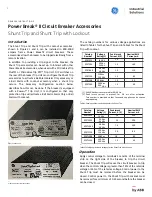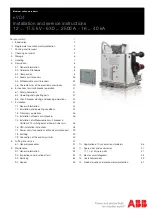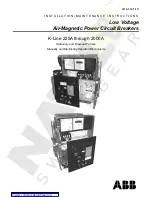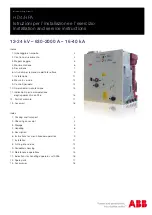
Installation
98/293
Revision 11 • INSTALLATION AND OPERATING INSTRUCTIONS • NXPLUS C • 802-9081.9
Set of assembly facilities
The "set of assembly facilities" (order no.: 802-9035.3, available at the regional Siemens
representative) is recommended. The "set of assembly facilities" comprises the following
auxiliary means:
• Certified lifting rods (crane rods) for lifting or lowering panels with panel widths of 600 mm
and 900 mm
- 2 lifting rods: Length 753 mm, Ø 20 mm
- 2 lifting rods: Length 1053 mm, Ø 20 mm
• 1 set with 4 ring eyes, washers and hexagon nuts each, for lifting low-voltage
compartments
• 1 handle for lifting or lowering voltage transformers type 4MT2 or 4MT3
• 12 supporting feet for secure standing of the panels
• 1 lever for removing the silicone insert of voltage transformers type 4MT3
• 1 voltage transformer assembly jack (scissor-type jack) for lifting or lowering voltage
transformers type 4MT3
• 3 extraction tools for the screw-type cone of the busbar
• 2 gauges for assembling the busbars
• 2 gauges for aligning panels with double busbars
• 2 tools for charging the circuit-breaker operating mechanism
• 1 adapter for emergency operation of the three-position switch
• 2 adjustment tools for aligning the switchgear vessels
13.4
Comments on electromagnetic compatibility
To achieve appropriate electromagnetic compatibility (EMC), some basic requirements must
be observed while erecting the switchgear. This applies especially to the installation and
connection of external cables and wires.
Basic measures for ensuring EMC are already taken during design and assembly of the
switchgear panels. Among other things, these measures include:
• The low-voltage compartment is an integral part of the panel, which means that the
protection and control devices with the internal wiring are metal-enclosed.
• Reliable earth connections of the frame parts via toothed contact washers or locking
washers.
• Inside the panel, wires are laid in metal ducts.
• Spatial separation of sensitive signal wires from wires with high interference voltage levels.
• Limitation of switching overvoltages of inductive loads (e.g. relay or contactor coils, motors)
by means of protective circuits with diode, varistor or RC element.
• Within the low-voltage compartment, the secondary devices are mounted in defined zones.
• Shortest possible connection between corresponding modules in subracks.
• Consideration of the magnetic leakage fields of conductor bars and cables.
• Protection of subracks and wiring backplanes against interference by perforated shielding
plates.
• Large surface bonding between all modules and devices as well as bonding to the earthing
conductor of the switchgear assembly.
These measures basically enable proper operation of the switchgear itself. The planner or
operator of the switchgear must decide whether additional measures are required depending
on the electromagnetic environment where the switchgear is installed. Such measures must
be implemented by the installation company in charge.
In an environment with heavy electromagnetic interference it may be necessary to use
shielded cables and wires for the external connections. This makes it possible to avoid
interferences in the low-voltage compartment and thus, undesired influences on the
electronic protection and control or other automation devices.
Cable shields must be electrically bonded to be able to carry high frequencies, and contacted
concentrically at the cable ends.
The shields of cables and wires are connected and earthed in the low-voltage compartment.
















































